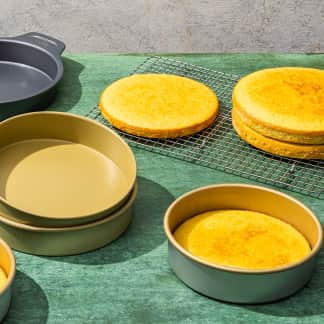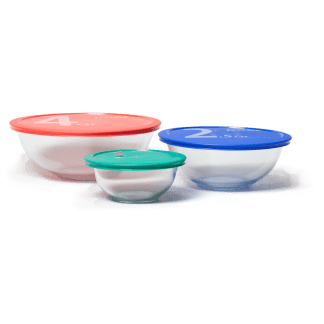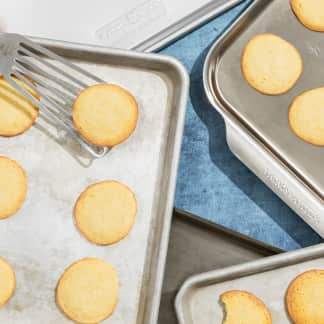Reviews You Can Trust.
See Why.
Baking Powder
We always assumed all baking powders were created equal. Boy, were we wrong.
Top Pick
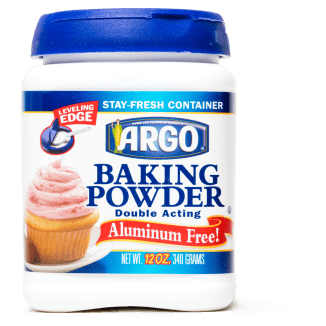
WinnerArgo Double Acting Baking Powder
This brand performed well in every test we threw at it, making “chewy” cookies, “fluffy” biscuits, and “moist” but “airy” cakes. Its easy-to-use plastic tub helped it edge out the competition.
Ingredients: Sodium acid pyrophosphate, sodium bicarbonate, cornstarch, and monocalcium phosphate
Average Cake Height: 1.09 in
Gas Released in Oven: 70%
Gas Released at Room Temperature: 30%
Price at Time of Testing: $1.73 for 12 oz ($0.14 per oz)
This brand performed well in every test we threw at it, making “chewy” cookies, “fluffy” biscuits, and “moist” but “airy” cakes. Its easy-to-use plastic tub helped it edge out the competition.
Ingredients: Sodium acid pyrophosphate, sodium bicarbonate, cornstarch, and monocalcium phosphate
Average Cake Height: 1.09 in
Gas Released in Oven: 70%
Gas Released at Room Temperature: 30%
Price at Time of Testing: $1.73 for 12 oz ($0.14 per oz)
Sign up for the Well-Equipped Cook newsletter
Shop smarter with our ATK Reviews team's expert guides and recommendations.
What You Need to Know
For such an indispensable ingredient, leavening remains an afterthought to most home bakers. But it’s undoubtedly essential: Without the transformative powers of leavening, many baked goods would emerge from the oven dense, flat, or hard.
Most leaveners work on the same principle: When added to a batter or dough, they release gas, creating air bubbles that lift the mixture. The most familiar natural leavener is yeast, which consumes the sugars in a dough and produces air bubbles. Resilient doughs, like bread doughs, are elastic and can contain gas bubbles for a relatively long period. Quick bread doughs and runny cake batters can’t hold gas bubbles for long, so when making these, we rely on fast-acting chemical leaveners.
There are two commonly available chemical leaveners, baking soda and baking powder. Baking soda is a single-ingredient product, whereas baking powder is a mix, combining baking soda with a powdered acid and a starch.
But the mix isn’t always the same from brand to brand. Since different combinations of ingredients are used in different brands of baking powder, we rounded up six nationally available products and had 21 America’s Test Kitchen staff members assess them in white cake, chocolate crinkle cookies, and cream biscuits.
To keep everything consistent, we carefully measured all the ingredients and baked the cakes in the same oven, one after another. When we lined up the cooled cakes side by side, we were astounded at the differences. Some cakes were tall and airy, while others were dense and squat. The thickness of the cakes varied by up to 20 percent—from 0.89 inch to 1.24 inches—and tasters preferred the delicate, tender crumb of taller cakes. (We baked the cakes three more times, always using freshly opened baking powders, and the results were the same.) What was going on?
Modern baking powders are “double acting,” meaning they release some of their carbon dioxide when moistened and the rest when heated. (True “single-acting” baking powders, by contrast, release all their gas when mixed with liquid and are rarely manufactured anymore.) Although all the baking powders we tested release approximately the same total amount of carbon dioxide gas, brands vary widely in the ratio released at room temperature versus at higher temperatures in the oven. This is important: If too much gas is released at room temperature, cakes won’t bake up tall and airy in the oven.
To get a better idea of the composition of each baking powder, we scrutinized ingredient labels and talked to manufacturers. We learned that the two densest and squattest cakes were made with baking powders that use just one acid, while stronger-performing brands have two forms of acid to bolster lift. Baking powders with just one acid create only 30 percent of their lift in the oven. By contrast, brands with two acids produce 60 to 90 percent of their lift in the oven and create baked goods that are airier, fluffier, and more tender.
But fluffier isn’t better in every application: Lower-rising baking powders actually made moister and chewier cookies. Brands that performed best in cake made cookies that were just a little too fluffy and cake-like. This wasn’t enough to drop these powders from the top of our rankings, but it did push them from the top spot: We were looking for a great all-purpose baking powder, after all. (Don’t worry, our winning baking powder still produces a tall, fluffy cake.)
Finally, since tasters didn’t notice flavor differences in other applications, we tried the baking powders the plainest way we could think of, in cream biscuits. Texture wasn’t an issue in this denser dough, except for one biscuit that took on a speckled, uneven appearance. (Our science editor explained that the baking powder used in that sample includes potassium bicarbonate, which can cause unwanted browning.) Flavor was more contentious, with 30 percent of tasters noting a metallic flavor in two samples. (Ingredient labels showed that the corresponding products contain aluminum compounds.) This wasn’t enough to be off-putting, but tasters preferred options with a clean flavor.
While we didn’t find any products that would ruin a baking project, we did find brands that make the difference between a decent cake and a great one.
Our favorite was an inexpensive all-purpose powder that produced tender cakes, soft biscuits, and perfectly chewy cookies.
What’s the Difference? Baking Powder versus Baking Soda
Baking soda and baking powder both perform the same job (leavening), but each does it in a different way. Baking soda is a single-ingredient product that reacts with acidic ingredients to release carbon dioxide and provide lift. In recipes with a high proportion of acidic ingredients like chocolate, fruit juice, yogurt, or buttermilk, baking soda performs well on its own.
Baking powder is a mix of baking soda (or another carbon-dioxide producing chemical), a powdered acid such as cream of tartar, and a starch to keep the chemicals dry. When moistened, the powdered acid reacts with the soda, releasing carbon dioxide for lift in recipes without a strong acidic component.
Everything We Tested
Highly Recommended

WinnerArgo Double Acting Baking Powder
This brand performed well in every test we threw at it, making “chewy” cookies, “fluffy” biscuits, and “moist” but “airy” cakes. Its easy-to-use plastic tub helped it edge out the competition.
Ingredients: Sodium acid pyrophosphate, sodium bicarbonate, cornstarch, and monocalcium phosphate
Average Cake Height: 1.09 in
Gas Released in Oven: 70%
Gas Released at Room Temperature: 30%
Price at Time of Testing: $1.73 for 12 oz ($0.14 per oz)
This brand performed well in every test we threw at it, making “chewy” cookies, “fluffy” biscuits, and “moist” but “airy” cakes. Its easy-to-use plastic tub helped it edge out the competition.
Ingredients: Sodium acid pyrophosphate, sodium bicarbonate, cornstarch, and monocalcium phosphate
Average Cake Height: 1.09 in
Gas Released in Oven: 70%
Gas Released at Room Temperature: 30%
Price at Time of Testing: $1.73 for 12 oz ($0.14 per oz)
Recommended
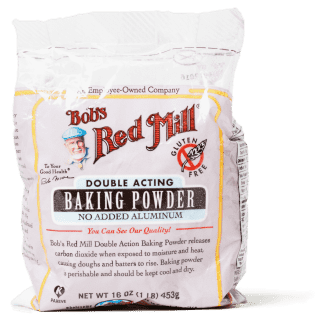
Bob's Red Mill Baking Powder
Cakes made with this baking powder were among the tallest and “fluffiest” of the bunch. Biscuits and cookies emerged from the oven “tender” and “airy.” Unfortunately, this brand’s frustrating plastic-bag packaging got it booted from the top spot.
Ingredients: Sodium acid pyrophosphate, sodium bicarbonate, cornstarch, and monocalcium phosphate
Average Cake Height: 1.19 in
Gas Released in Oven: 90%
Gas Released at Room Temperature: 10%
Price at Time of Testing: $3.29 for 16 oz ($0.21 per oz)
Cakes made with this baking powder were among the tallest and “fluffiest” of the bunch. Biscuits and cookies emerged from the oven “tender” and “airy.” Unfortunately, this brand’s frustrating plastic-bag packaging got it booted from the top spot.
Ingredients: Sodium acid pyrophosphate, sodium bicarbonate, cornstarch, and monocalcium phosphate
Average Cake Height: 1.19 in
Gas Released in Oven: 90%
Gas Released at Room Temperature: 10%
Price at Time of Testing: $3.29 for 16 oz ($0.21 per oz)

Calumet Baking Powder
This brand made “taller,” “airier,” and “more tender” cakes and biscuits than any other brand, but the extra oomph produced cookies that were a little “too cake-y.” Some tasters detected a slight “metallic” taste in biscuits.
Ingredients: Baking soda, cornstarch, sodium aluminum sulfate, calcium sulfate, monocalcium phosphate
Average Cake Height: 1.24 in
Gas Released in Oven: Proprietary
Gas Released at Room Temperature: Proprietary
Price at Time of Testing: $2.49 for 7 oz ($0.36 per oz)
This brand made “taller,” “airier,” and “more tender” cakes and biscuits than any other brand, but the extra oomph produced cookies that were a little “too cake-y.” Some tasters detected a slight “metallic” taste in biscuits.
Ingredients: Baking soda, cornstarch, sodium aluminum sulfate, calcium sulfate, monocalcium phosphate
Average Cake Height: 1.24 in
Gas Released in Oven: Proprietary
Gas Released at Room Temperature: Proprietary
Price at Time of Testing: $2.49 for 7 oz ($0.36 per oz)
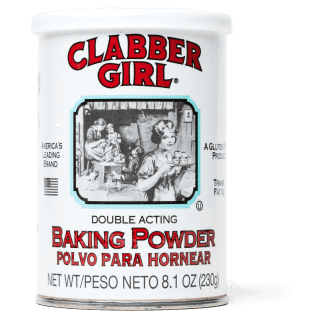
Clabber Girl Baking Powder
“Pillowy” cakes and “tender” cookies earned this brand high marks for texture, but 30 percent of tasters picked up on an off, “metallic” flavor in biscuits from the addition of sodium aluminum sulfate.
Ingredients: Cornstarch, sodium bicarbonate, sodium aluminum sulfate, monocalcium phosphate
Average Cake Height: 1.1 in
Gas Released in Oven: 60%
Gas Released at Room Temperature: 40%
Price at Time of Testing: $2.27 for 8.1 oz ($0.28 per oz)
“Pillowy” cakes and “tender” cookies earned this brand high marks for texture, but 30 percent of tasters picked up on an off, “metallic” flavor in biscuits from the addition of sodium aluminum sulfate.
Ingredients: Cornstarch, sodium bicarbonate, sodium aluminum sulfate, monocalcium phosphate
Average Cake Height: 1.1 in
Gas Released in Oven: 60%
Gas Released at Room Temperature: 40%
Price at Time of Testing: $2.27 for 8.1 oz ($0.28 per oz)
Recommended with reservations
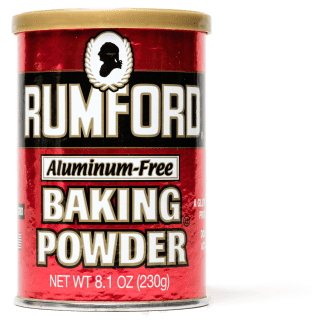
Rumford Baking Powder
This brand, which releases 70 percent of its carbon dioxide at room temperature, made “shallower,” “heavier” cake. While not our preferred baking powder for cakes, this product produced “chewy” crinkle cookies and “fluffy” biscuits.
Ingredients: Monocalcium phosphate, sodium bicarbonate, cornstarch (made from non-genetically modified cornstarch)
Average Cake Height: 1.02 in
Gas Released in Oven: 30%
Gas Released at Room Temperature: 70%
Price at Time of Testing: $3.47 for 8.1 oz ($0.43 per oz)
This brand, which releases 70 percent of its carbon dioxide at room temperature, made “shallower,” “heavier” cake. While not our preferred baking powder for cakes, this product produced “chewy” crinkle cookies and “fluffy” biscuits.
Ingredients: Monocalcium phosphate, sodium bicarbonate, cornstarch (made from non-genetically modified cornstarch)
Average Cake Height: 1.02 in
Gas Released in Oven: 30%
Gas Released at Room Temperature: 70%
Price at Time of Testing: $3.47 for 8.1 oz ($0.43 per oz)
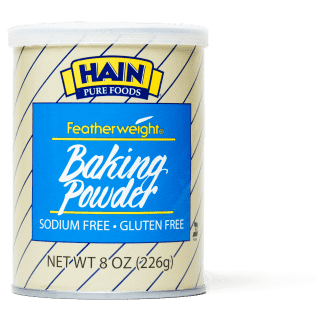
Hain Pure Foods Featherweight Baking Powder
This brand uses an atypical combination of ingredients to produce a salt-free and corn-free baking powder, but it comes at a price. While cookies were perfectly “fudgy,” cakes were “dense” and biscuits had a “speckled” appearance (but tasted fine).
Ingredients: Monocalcium phosphate, potato starch, potassium bicarbonate
Average Cake Height: 0.89 in
Gas Released in Oven: 30%
Gas Released at Room Temperature: 70%
Price at Time of Testing: $5.39 for 8 oz ($0.67 per oz)
This brand uses an atypical combination of ingredients to produce a salt-free and corn-free baking powder, but it comes at a price. While cookies were perfectly “fudgy,” cakes were “dense” and biscuits had a “speckled” appearance (but tasted fine).
Ingredients: Monocalcium phosphate, potato starch, potassium bicarbonate
Average Cake Height: 0.89 in
Gas Released in Oven: 30%
Gas Released at Room Temperature: 70%
Price at Time of Testing: $5.39 for 8 oz ($0.67 per oz)
*All products reviewed by America’s Test Kitchen are independently chosen, researched, and reviewed by our editors. We buy products for testing at retail locations and do not accept unsolicited samples for testing. We list suggested sources for recommended products as a convenience to our readers but do not endorse specific retailers. When you choose to purchase our editorial recommendations from the links we provide, we may earn an affiliate commission. Prices are subject to change.
Reviews You Can Trust
The mission of America’s Test Kitchen Reviews is to find the best equipment and ingredients for the home cook through rigorous, hands-on testing. Have a question or suggestion? Send us an email at atkreviews@americastestkitchen.com. We appreciate your feedback!
Reviews You Can Trust.
See Why.

